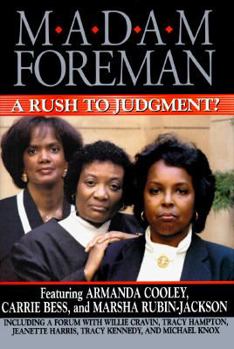Madam Foreman: A Rush to Judgment
In the words of jury foreman Armanda Cooley, jurors Marsha Rubin-Jackson and Carrie Bess, and a cast of five other former jurors are the answers to the questions that the nation has been asking since... This description may be from another edition of this product.
Format:Hardcover
Language:English
ISBN:0787109185
ISBN13:9780787109189
Release Date:January 1996
Publisher:Audio Literature
Length:237 Pages
Weight:1.15 lbs.
Dimensions:1.1" x 6.3" x 9.3"
Customer Reviews
1 rating
The View from the Jury Box
Published by Thriftbooks.com User , 16 years ago
The Trial of O. J. Simpson covered "wealth, fame, celebrity, sex, race, adultery, drugs, domestic abuse, and murder". Public opinion was mostly based on race, which is not the best method to determine guilt or innocence. Any jury decides the facts in the case to resolve conflicting claims. Given the murders occurred after 11pm no other true verdict was possible. Joseph Bosco said the news on TV made the trial different from what he observed in the courtroom. This can explain mistaken opinions. This book is important because of the insight as to the jury's decision, assuming nothing was left out or distorted. After the verdict the jurors wanted to avoid the plague of journalists (Chapters 1 & 2). Some were approached to sell their story. They did not want to be on TV because of all the crazy people out there (p.18). Were those offers of payment reliable (p.19)? Maybe not (p.20). A "Letter of Intent" isn't a cashier's check (p.21). A book will provide money up front and insure the story is honest, not garbled as in a late night talk show, tabloid news, or corporate TV shows (p.23). Chapters 3, 4, and 5 tell about the lives of the co-authors. Chapter 6 explains the nine months as a sequestered juror. Being isolated affected people's nerves (p.72). The jurors believed their rooms had audio and video monitors (p.85). They would have preferred to go home a few times to check things out. Chapter 7 describes the witnesses at the trial. The coroner was not called in a timely manner (p.100). Why wasn't Simpson's house searched (p.101)? Fuhrman wasn't credible (p.104), or Vannatter (p.106). Some of the prosecution witnesses weren't credible (p.116). There was a problem with the blood evidence from the fence (pp.121-122). Simpson's blood wasn't on either of the gloves (p.123). Some believed the gloves fit (p.126). The domestic abuse testimony showed it happened when they were drunk (p.127). "Marcia Clark did an excellent job" (p.137). They had a problem with the way the evidence was gathered and preserved (p.140). Chapter 9 tells how the jury arrived at their verdict. They had several reasonable doubts plus questions that could not be answered from the exhibits and evidence (p.156). The testimony of the limo driver said OJ was in the doorway, not the driveway (p.157). The time element was a big factor (p.160). There was a problem with the bloody glove (p.161). After talking over the evidence the verdict was not guilty on both counts. The jury's verdict caused Judge Ito's expression on his face to change (p.174). "The evidence just was not there" (p.177). A juror noted the lack of blood evidence from the crime scene was questionable (p.178). The coroner who performed the autopsies wasn't allowed to testify. Chapter 11 is titled "The Race Card". At first they thought OJ was guilty. The subject of race was not a part of the deliberations (p.181). The lack of evidence and the shoddy prosecution led to the verdict (p.182). [Those who charge racism may be conf




